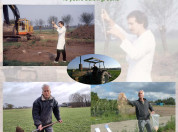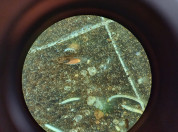Search
Search results
-
National Growth Fund finances Dutch Holomicrobiome Institute
The government of the Netherlands has allocated €200 million from the country’s National Growth Fund for a public-private consortium that will conduct research into 'microbiomes' and economically interesting applications thereof. In the consortium, NIOO is partnering with ten Dutch universities, five university-medical centres, four universities of applied sciences, many other knowledge organisations and together with dozens of small and large companies and societal organisations.
-
From Pioneer to Soil Prophet: 40 years belowground - Farewell symposium Wietse de Boer
On Thursday April 4 we'll have the Farewell Symposium and reception for our long-time colleague Prof. Dr Wietse de Boer (Department of Microbial Ecology at NIOO and Wageningen University).
-
Greenhouse gases
Climate change is amplified by greenhouse gas emissions. At NIOO, we work on the fundamental understanding of how gases such as methane, carbon dioxide and nitrogen dioxide influence ecosystems. Our knowledge of carbon and nitrogen cycles provides insight into the potential of greenhouse mitigation tools. In a Dutch freshwater lake or the soil of a tropical rain forest.
-
The Centre for Soil Ecology goes national
Today, on World Soil Day, it is the perfect moment to present the new National Centre for Soil Ecology. All soil ecologists working in the Netherlands can now connect to the initiative that originally started in Wageningen.
-
Film 'Onder het Maaiveld' revisited - English version
To honour the International Day of Biodiversity, with NIOO soil ecologists for Q&A afterwards!
-
Beneath your feet, soil microbes are getting fat
Microbes, like humans, can eat 'junk food' and grow fat. This even happens when you might not expect it, according to NIOO researcher Kyle Mason-Jones
-
Enhancing Soil Biodiversity
At NIOO, we are on a mission to explore the strange world beneath our feet, to seek out new soil-borne life, uncover new miniature civilisations, and to boldly take humankind where it could not go before.
-
Eiko Kuramae's inaugural lecture
Op dinsdag 11 april houdt Eiko Kuramae haar oratie als hoogleraar Microbial Community Ecology & Environmental Genomics in Utrecht
-
Developing digital twins to help understand ecosystems
LTER-LIFE aims to study and predict how global change affects ecosystems. It is one of nine projects that have just won funding for setting up and improving large-scale research infrastructure.
-
Soil biodiversity analysis for sustainable production systems (SoilProS)
SoilProS will interpret big data on soil biodiversity, soil chemical and physical characteristics with respect to current and desired soil functions, and how to use this information in order to help farmers predicting which crop varieties, seed mixtures, (organic) fertilizers, soil inocula, and organic substrates enhance the environmental sustainability of their activities.
